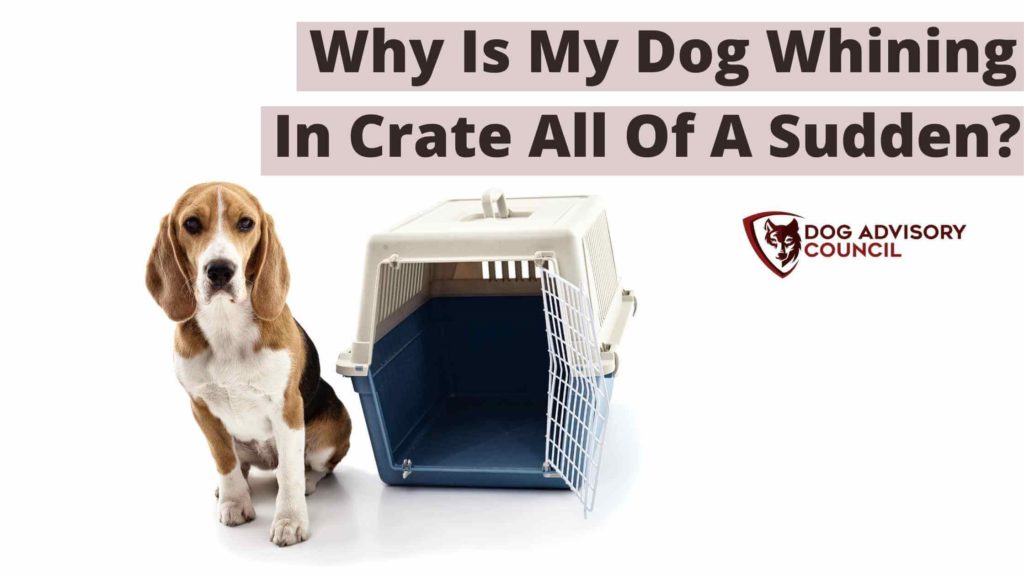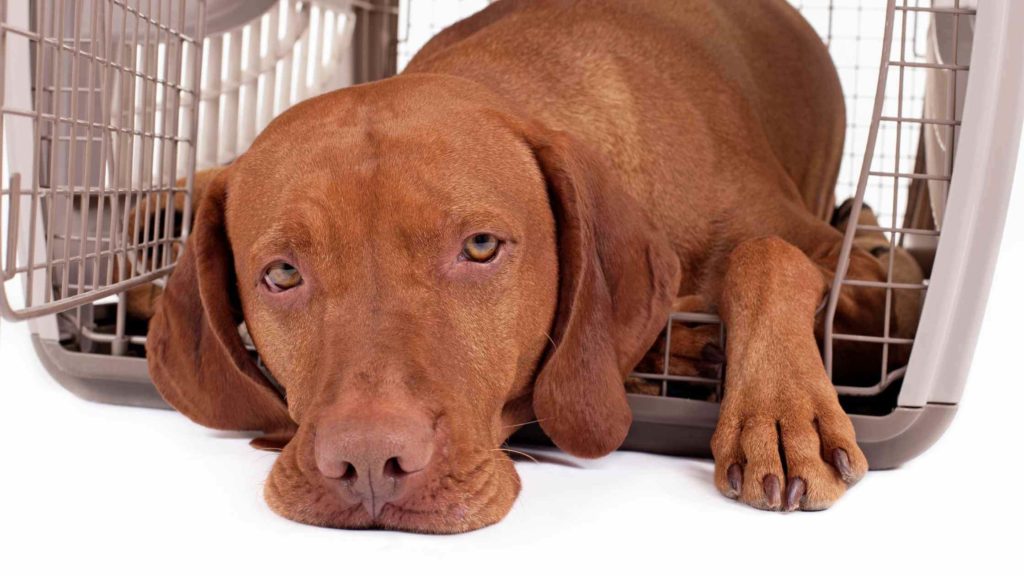
Is your dog suddenly making lots of noise when you put them in their crate? What’s going on? Here are several reasons if you noticed your dog whining in crate all of a sudden.
There could be several normal reasons and several abnormal reasons for a dog to suddenly start whining in their crate suddenly. These include changes in diet, changes in bedtime/crate time, boredom, stress, a problem with the crate, or even illness or injury.
It’s essential to take your dog’s sudden whining seriously so that you can ensure it’s for a typical reason and not for an abnormal reason. Getting to the bottom of the problem will help you address this annoying behavior.
7 Reasons for a dog to be whining in a crate all of a sudden
As mentioned, there are many possible reasons for your dog to be whining when they are in their crate. Common reasons include:
- They’ve had a change in diet
- There’s been a change in bedtime or crate time
- They’re bored
- They’re stressed
- There’s a problem with their crate
- They are ill
- They are hurt
1. They’ve had a change in diet
If you’ve changed your dog’s diet, especially suddenly, they’re bound to have an upset stomach or at least some discomfort. This could mean that your dog will complain about having to lie confined in a crate. Many dogs will prefer to roam to help with digestion. Or at least sprawl out to minimize discomfort.
2. There’s been a change in bedtime or crate time
If you bar your dog in their crate during bedtime or when you go to work, your dog will start to learn the timings. If that schedule suddenly changes, it can be upsetting for them. It’ll also confuse them. Dogs will whine to let you know that it’s the wrong time and protest this schedule change.
3. They’re bored
If dogs are bored in their crate, they’ll start to complain when you bar them in there. This is common with small crates. There’s not much room for dogs to move around, and there is little space for toys. If you make their crate more entertaining and ensure that they get plenty of exercise sessions each day, this will help a lot!
4. They’re stressed
Stress has a serious impact on dogs! Dogs may be stressed if their blanket is too thin. Or if they are upset about something else entirely. Or just stressed because something went bump during the night.
A stressed dog will whine because they want to be free to move around and seek comfort. This can be hard to determine, both the stress and the trigger, but it is valid and should be addressed.
5. There’s a problem with their crate
Maybe there is a sharp part poking them. Or, the crate is too small. Or maybe it’s in a scary place, or it’s too cold or too warm, etc. If they are uncomfortable physically, they will let you know by whining. Try changing their bedding or the crate’s location to see if that helps! Your dog just wants to be comfortable, after all.
6. They are ill
A sick dog will complain even more about going in their crate. You’ll want to ensure that you take your dog to the vet to see what’s going on if you have any other reason to think that they are sick. While this isn’t the first reason dogs complain, it’s one to think about if you notice other symptoms or you’ve exhausted the other ones.
7. They are hurt
There should be other signs that our dog is hurt, of course. Licking at a specific part of their body or showing pain indicators. If you suspect that they are hurt, you’ll want to take them to the vet to be sure. Better safe than sorry, right?
Whining at night versus in the daytime
Your dog whining during the day in his crate can sometimes be a bit more worrying than nighttime crate whining. Daytime whining often shows more of a problem because everything is normal. If they cry at night, it’s often an issue with comfort, bladder, and more. However, this is in most cases. Still, take the time to sort out what’s going on for your dog’s comfort.
It also depends, of course, on when you usually pen your dog in! Changing from one to the other can be enough to completely confuse your dog since they’ll associate the crate with a specific time of day rather than a need you are meeting.
What should I do if my dog suddenly hates the crate?
It can be frustrating when your dog starts to whine in their crate, especially because you know that everything is okay. However, to your dog, it’s a crucial issue. When trying to approach the situation, you’ll want to focus on the following details:
- Assess the problem
- Understand what needs to change
- Change what’s needed
- Reintroduce your dog to the crate
Even if the change you make is small and insignificant (to you), make it. After a break of a day or two break, reintroduce your dog to the crate as normal. They may just settle right in and be totally fine. Or, they may continue to complain and whine. If they do, you’ll need to re-do these steps.
If you’ve done everything you can think of to help your dog and he’s still whining in his crate, you may want to bring in a specialist or take your dog to the vet to make sure that everything is okay!

Why is my older dog whining in create all of a sudden?
Senior dogs are known for having changes in their health, which can impact their comfort in the crate.
For example, senior dogs can’t control their bladder as they used to when younger. This means they’ll need to go out more frequently or need more pee pads. If they don’t have that ability, you’ll notice them crying more when you put them in their crate. Always make sure that you put some pee pads in as they age.
Another common reason is that senior dogs have more intense comfort needs, much like humans. This means that they may need a softer bed or need to get out and stretch more often. All of these are common with older dogs.
In some cases, you may need to shift your idea of your older dog in a crate. For example, get a large crate where you can put a bigger and softer bed in it. Or, look at the idea of a playpen or something that still confines your dog but helps them enjoy more comfort.
A senior dog may not be able to comfortably or safely stay in a crate, and it’s important that you respect that if this is the case. A vet can help you determine that and also give you some great suggestions that will offer more comfort to your dog and keep them contained.
How to get my dog to like his crate again
If you’ve got the problem fixed, then you’re going to need to show your dog that everything is “back to normal” when it comes to the crate itself. Steps to do that include:
- Leave the crate door open and let your dog explore it
- Pair the crate with positive things
- Put them in for short periods at first, and increase
All of these things help your dog to check out the crate, see that it’s no longer the “bad thing” that it was before, and relax a bit more. They still may whine when going into the crate, but after seeing that it’s no longer a problem, things should go back to normal.
If the whining continues, don’t assume your dog’s just being dramatic — something else might be wrong that needs your attention. Respect your dog’s whines and take a closer look!
Should I ignore my dog whining in a crate?
This is a hard thing to sort out, really. Let’s be honest: sometimes the reality is that dogs are being dramatic, or they’re simply complaining because they don’t want to be in the crate!
Generally, you can safely ignore your dog whining in the crate if it’s only a little bit, and you know that he and his crate are both fine. He’s just vocalizing his concerns. If you give in to every whine, he’ll continue to do it because it’ll get your attention!
If your dog’s whining is persistent and it’s a deliberate whine (if it’s shrill, for example), then you don’t want to ignore it. Your dog is trying to signal something to you, and you must take that seriously for everyone’s health, safety, and comfort. Since you will know his normal whines from his abnormal whines, you’ll be able to tell when he’s signaling a real problem.
In brief
A dog suddenly whining in his crate could be for minor reasons, such as a diet change, a change in schedule, or boredom. It could also indicate a larger problem, such as stress, a problem with the crate, or even illness or injury. Getting to the bottom of the problem means taking a closer look at all of those facets and sorting out what to do.
It’s important to understand what’s going on when it comes to your dog’s sudden hatred or discomfort in the cate. Whether a big problem or a small one, fixing it will be crucial to help your dog get comfortable in his crate again! Know someone who is looking for advice on this very issue? Share this with them!
